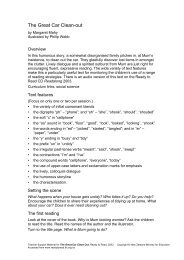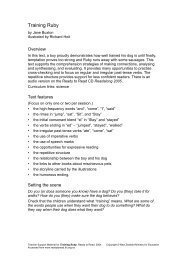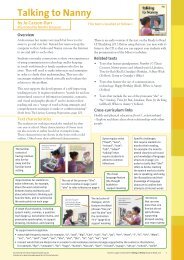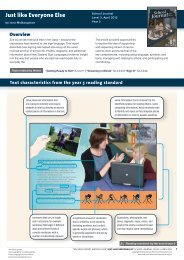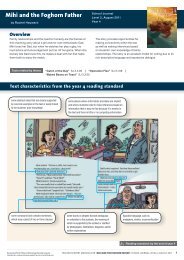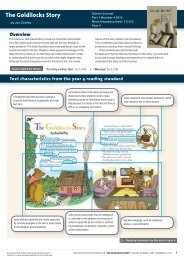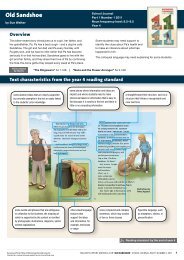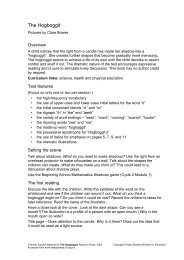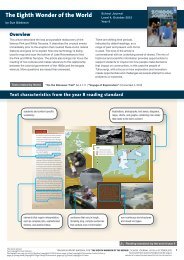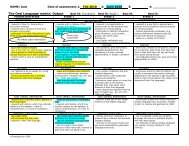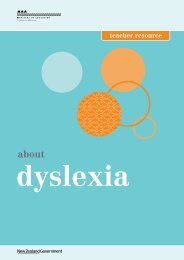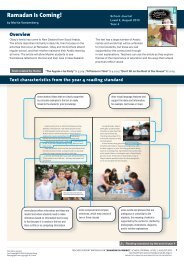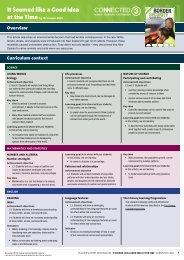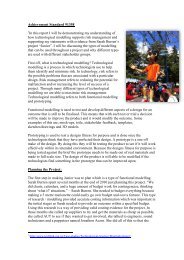Hinemoa and TÅ«tÄnekai JJ46 (PDF 421KB) - Literacy Online
Hinemoa and TÅ«tÄnekai JJ46 (PDF 421KB) - Literacy Online
Hinemoa and TÅ«tÄnekai JJ46 (PDF 421KB) - Literacy Online
Create successful ePaper yourself
Turn your PDF publications into a flip-book with our unique Google optimized e-Paper software.
<strong>Hinemoa</strong> <strong>and</strong> Tūtānekai<br />
(A legend from the Te Arawa iwi)<br />
Junior Journal 46<br />
Level 2<br />
This text is levelled at Gold 1<br />
Junior<br />
Journal<br />
46<br />
LEVEL<br />
2<br />
Overview<br />
This text is a retelling of a legend of the Te Arawa people. It<br />
tells the love story of <strong>Hinemoa</strong> <strong>and</strong> Tūtānekai. Tūtānekai lives<br />
on Mokoia Isl<strong>and</strong>, separated from <strong>Hinemoa</strong> by the waters of<br />
Lake Rotorua. <strong>Hinemoa</strong>’s father does not want the two young<br />
people to be together <strong>and</strong> tries to stop them from meeting.<br />
But <strong>Hinemoa</strong> is determined <strong>and</strong> risks her life to swim across<br />
Lake Rotorua to be with Tūtānekai. “<strong>Hinemoa</strong> <strong>and</strong> Tūtānekai”<br />
requires students to “confidently use a range of processing<br />
<strong>and</strong> comprehension strategies to make meaning from <strong>and</strong><br />
think critically about” text (from The <strong>Literacy</strong> Learning Progressions,<br />
page 14).<br />
This text provides opportunities for the students to make<br />
connections to their prior knowledge of legends to help<br />
them summarise <strong>and</strong> predict the main events <strong>and</strong> to make<br />
inferences.<br />
This journal includes an article about Mokoia Isl<strong>and</strong>. “The<br />
Gulls of Mokoia Isl<strong>and</strong>” explains why the red-billed gull is<br />
considered sacred by the Te Arawa people.<br />
There is an audio version of the text as an MP3 file at www.<br />
juniorjournal.tki.org.nz<br />
Text characteristics<br />
Key text characteristics relating to the reading st<strong>and</strong>ard for after three years at school are shown in the boxes with a solid outline.<br />
Many characters <strong>and</strong> events <strong>and</strong><br />
more than one storyline, portraying<br />
contrasting points of view<br />
Some unfamiliar contexts<br />
<strong>and</strong> settings. Shifts in<br />
time <strong>and</strong>/or place<br />
A mix of explicit <strong>and</strong> implicit content within the text <strong>and</strong><br />
illustrations that requires students to make connections<br />
between ideas in the text <strong>and</strong> their prior knowledge to<br />
make simple inferences, for example, that the physical<br />
distance between <strong>Hinemoa</strong>’s home <strong>and</strong> Mokoia Isl<strong>and</strong> is<br />
a huge barrier for <strong>Hinemoa</strong> to reach Tūtānekai<br />
On the next calm night, <strong>Hinemoa</strong> heard Tūtānekai’s<br />
pūtōrino <strong>and</strong> crept down to the lake. The waka had<br />
been moved! What could she do? She was determined<br />
to get across to the isl<strong>and</strong>. She thought of another<br />
way, but she knew it was full of danger. She tied six<br />
hue (water containers) to her body to help her float.<br />
In the darkness, she went into the lake <strong>and</strong> began<br />
swimming to Mokoia Isl<strong>and</strong>.<br />
<strong>Hinemoa</strong> was a strong swimmer, but she was<br />
soon tired. The sound of the pūtōrino calling to<br />
her gave her strength to carry on. She knew that<br />
They met again many times, but Tūtānekai always<br />
soon she would be with Tūtānekai.<br />
had to return with his family across the water.<br />
<strong>Hinemoa</strong> <strong>and</strong> Tūtānekai wanted to be together,<br />
but <strong>Hinemoa</strong>’s father, Umukaria, would not agree.<br />
He was an important chief, <strong>and</strong> he wanted to choose<br />
a husb<strong>and</strong> for his daughter.<br />
At last they worked out a way to be together.<br />
They agreed that on a calm night, Tūtānekai would<br />
play his pūtōrino (flute) <strong>and</strong> <strong>Hinemoa</strong> would paddle<br />
a waka over to Mokoia Isl<strong>and</strong> to join him. <strong>Hinemoa</strong>’s<br />
father thought she might try to do this, so every night,<br />
he made his men drag the waka up the beach, away<br />
from the water’s edge. He knew <strong>Hinemoa</strong> couldn’t<br />
launch the waka by herself.<br />
20<br />
21<br />
A variety of sentence structures,<br />
including complex sentences<br />
Some unfamiliar words <strong>and</strong> phrases, including<br />
Māori words, the meaning of which is supported<br />
by the context or illustrations, or by bracketed<br />
definitions within the running text<br />
The <strong>Literacy</strong> Learning Progressions<br />
Reading st<strong>and</strong>ard: after three years at school<br />
The above spread:<br />
Text copyright © Crown<br />
Illustrations copyright © Crown<br />
Teacher support material for “<strong>Hinemoa</strong> <strong>and</strong> Tūtānekai”, Junior Journal 46<br />
Copyright © New Zeal<strong>and</strong> Ministry of Education 2013<br />
Accessed from www.juniorjournal.tki.org.nz<br />
ISBN 978 0 7903 4281 8 (ONLINE)<br />
1
Possible curriculum contexts<br />
English (Reading)<br />
Level 2 –<br />
Ideas: Show some underst<strong>and</strong>ing of ideas<br />
within, across, <strong>and</strong> beyond texts.<br />
Structure: Show some underst<strong>and</strong>ing of text<br />
structures.<br />
Social Sciences (Social Studies)<br />
Level 1 –<br />
Underst<strong>and</strong> how the past is important to<br />
people.<br />
Underst<strong>and</strong> how places in New Zeal<strong>and</strong> are<br />
significant for individuals <strong>and</strong> groups.<br />
The New Zeal<strong>and</strong> Curriculum<br />
Reading purposes <strong>and</strong> learning goals<br />
Suggested reading purpose<br />
(What can the students expect to find out or think about as a result of reading this text?)<br />
• To underst<strong>and</strong> that legends are important in sharing knowledge through generations<br />
• To use clues in the text to describe what the characters are like<br />
Setting a learning goal<br />
(What opportunities does this text provide for students to learn more about how to “read, respond to, <strong>and</strong> think<br />
critically” about texts?)<br />
Select <strong>and</strong> adapt from the suggestions below according to your students’ strengths, needs, <strong>and</strong> experiences – their<br />
culture, language, <strong>and</strong> identity. (Reading <strong>and</strong> Writing St<strong>and</strong>ards for Years 1–8, Knowledge of the Learner, page 6).<br />
• The students make connections to their prior knowledge of traditional stories in order to form <strong>and</strong> test<br />
hypotheses about the events in the text.<br />
• They summarise the main events in the text as they arise.<br />
• They make inferences <strong>and</strong> share their ideas about why the characters behave as they do.<br />
• They identify main ideas <strong>and</strong> form an opinion as to why this story is passed on by the people of Te Arawa.<br />
The <strong>Literacy</strong> Learning Progressions<br />
Text <strong>and</strong> language features<br />
Vocabulary<br />
• The Māori words, including the names<br />
of characters (“<strong>Hinemoa</strong>”, “Tūtānekai”,<br />
“Umukaria”) <strong>and</strong> places (“Ōwhata”, “Rotorua”,<br />
“Mokoia”) <strong>and</strong> other nouns (“hui”, “pūtōrino”,<br />
“hue”, “waka”)<br />
• The use of macrons to denote long vowels in<br />
the Māori words<br />
• Some possibly unfamiliar English words, such<br />
as “launch”, “determined”, “containers”.<br />
Text features<br />
• Knowledge of a legend<br />
• The complex sequence of events on pages 22–23<br />
• Compound sentences.<br />
Specific knowledge<br />
• Of legends <strong>and</strong> this legend in particular<br />
• Of Lake Rotorua <strong>and</strong> Mokoia Isl<strong>and</strong>.<br />
Possible supporting strategies<br />
Monitor the students’ word-solving attempts by noticing their use of words from the text during discussion. You<br />
may need to explain the use of the macron to denote a long vowel sound.<br />
Prompt them to remember the strategies they can use, often in combination, for example, when decoding the<br />
Māori words:<br />
• use their knowledge of Māori vowel sounds to distinguish between “hui” <strong>and</strong> “hue”<br />
• use their knowledge of the digraph “wh” to work out “Ōwhata”<br />
• break words into smaller chunks (“U-mu-ka-ri-a”). Remind the students that they can use this strategy<br />
for the English words (“de-ter-mined”, “con-tain-ers”).<br />
When supporting English language learners with breaking words into syllables, also show them which syllable<br />
is stressed (“de-ter-mined”, “con-tain-ers”). This is a significant part of saying <strong>and</strong> hearing words of more than<br />
one syllable in English.<br />
Prompt the students to think about the context <strong>and</strong> look for definitions in the text, for example, the bracketed<br />
definitions of “pūtōrino” <strong>and</strong> “hue” to clarify word meanings.<br />
Have English <strong>and</strong> Māori dictionaries available to confirm or clarify word meanings. To check English words, have<br />
other bilingual dictionaries, where appropriate, available for students who have a first language other than English.<br />
Help students to underst<strong>and</strong> that a legend is a story that may or may not have happened but has been<br />
passed on from person-to-person because it has important meaning. You could refer to or reread the RTR<br />
version of “Māui <strong>and</strong> the Sun”.<br />
Help students track the parallel storylines involving <strong>Hinemoa</strong> <strong>and</strong> Tūtānekai by using a graphic organiser.<br />
(See Reading <strong>and</strong> discussing the text.)<br />
If necessary, model reading some of the compound sentences aloud, in particular the use of commas to<br />
support phrasing.<br />
If you find that the students have little knowledge of legends, take time to read <strong>and</strong> enjoy examples from<br />
the library with the whole class. Ask students to share legends they know, including legends from their<br />
cultures. Give students who share a first language other than English the opportunity to discuss legends in<br />
this language.<br />
The map of Lake Rotorua within the article “The Gulls of Sulphur Bay” <strong>and</strong> the article “The Gulls of Mokoia<br />
Isl<strong>and</strong>” both provide support for the concept of the isl<strong>and</strong> being in the middle of a large lake.<br />
Metacognition<br />
Effective readers are metacognitive. They are aware of the processes <strong>and</strong> strategies they draw on <strong>and</strong> are able to explain how they use these to<br />
successfully make meaning <strong>and</strong> think critically. Examples of metacognitive behaviours, or strategies teachers can use to promote metacognitive behaviours, are threaded through<br />
the notes <strong>and</strong> indicated by .<br />
HOW YOU CAN SUPPORT YOUR STUDENTS TO BE METACOGNITIVE<br />
Ask questions: How did you know that bit was wrong? Or: I noticed that you reread that bit when you got confused. How did rereading help you?<br />
Use prompts: Think about what you can do to find help with the meaning of that word. Look at the rest of the sentence. How did it help you?<br />
Sounds <strong>and</strong> Words<br />
Ask questions: What did you learn from reading the legend? How do you feel about the character of Tūtānekai? <strong>Hinemoa</strong>? Umukaria? How did your opinions change during the<br />
reading? What made you change your opinion?<br />
Accessed from www.juniorjournal.tki.org.nz<br />
Copyright © New Zeal<strong>and</strong> Ministry of Education 2013<br />
Teacher support material for “<strong>Hinemoa</strong> <strong>and</strong> Tūtānekai”, Junior Journal 46 2
Introducing the text<br />
• Tell the students you have a Māori legend called “<strong>Hinemoa</strong> <strong>and</strong><br />
Tūtānekai” for them to read. Invite them to share their knowledge of this<br />
legend.<br />
• Look through the story together, clarifying who the characters are <strong>and</strong><br />
discussing the illustrations.<br />
• Alternatively, you may choose to have the students listen to the audio<br />
version of the story before they read it for themselves. For English<br />
language learners, listening to this story several times before reading<br />
would provide a good introduction to reading the text. Before listening,<br />
discuss the illustrations <strong>and</strong> introduce, explain, <strong>and</strong> record key<br />
vocabulary, including the names of the characters.<br />
• Clarify the setting in the early days of New Zeal<strong>and</strong>. For students who<br />
have read “The Gulls of Sulphur Bay” or “The Gulls of Mokoia Isl<strong>and</strong>”,<br />
confirm that this story is set in <strong>and</strong> around Lake Rotorua.<br />
• Draw out the idea that these are very old stories, passed on by word<br />
of mouth. They have been told over <strong>and</strong> over again because they are<br />
important, <strong>and</strong> some of the details change but the main ideas stay the<br />
same.<br />
• Prompt the students to recall a myth or legend they know, such as<br />
Māui <strong>and</strong> the Sun. Discuss some of the common features, for example,<br />
a setting in a long-ago time <strong>and</strong> (sometimes, as in this instance) in a<br />
special place, a brave hero (male or female), one or more problems to be<br />
overcome, <strong>and</strong> a happy ending.<br />
• Share the reading purpose <strong>and</strong> learning goal(s).<br />
Reading <strong>and</strong> discussing the text<br />
Instructional strategies you can use to support the students to achieve the learning goals are in the right-h<strong>and</strong> column. Select from <strong>and</strong> adapt the suggestions<br />
below according to your students’ needs.<br />
What to look for, prompt, <strong>and</strong> support as the students<br />
work towards achieving their learning goal<br />
Page 19<br />
The students draw on information in the illustration <strong>and</strong> make connections<br />
to their knowledge of legends to clarify the setting in the distant past. When<br />
reading, they identify the geographical setting as being in Lake Rotorua.<br />
The students identify information about the main characters <strong>and</strong> summarise<br />
the events so far.<br />
Page 20<br />
The students use the information about Umukaria, <strong>Hinemoa</strong>’s father, to make<br />
an inference about why he did not approve of Tūtānekai (for example, he didn’t<br />
want her to live far away; he wanted her to marry a chief’s son; he didn’t think<br />
Tūtānakei was good enough).<br />
The students summarise the new events, identifying the problems in the<br />
legend <strong>and</strong> explaining <strong>Hinemoa</strong> <strong>and</strong> Tūtānekai’s plan.<br />
With support, they make connections between the ideas that Mokoia Isl<strong>and</strong> is<br />
far away from Ōwhata, <strong>and</strong> the setting in the distant past (so no cellphones), to<br />
infer that the pūtōrino is an important part of the plan: Tūtānekai will use it as a<br />
signal when the water by Mokoia Isl<strong>and</strong> is calm <strong>and</strong> therefore safe for <strong>Hinemoa</strong><br />
to make the trip.<br />
The students hypothesise about what she will do when she discovers that her<br />
father has moved the waka.<br />
How you can support students to read, respond,<br />
<strong>and</strong> think critically<br />
Prompt the students to discuss the illustration (a young woman in the<br />
foreground, the characters wearing traditional Māori clothing, men pulling a<br />
waka onto the shore; <strong>and</strong> an isl<strong>and</strong> in the background). You could show them<br />
the map of Lake Rotorua on page 15 of “The Gulls of Sulphur Bay”. Remind the<br />
students that this is a legend from long ago.<br />
If necessary, support the students with the pronunciation of the Māori words<br />
<strong>and</strong> explain what a hui is.<br />
Tell me what you have found out about the characters. Start a summary chart,<br />
headed up with the names of the two main characters, leaving space to add<br />
the name of <strong>Hinemoa</strong>’s father. Record the information that the students have<br />
identified (for example, <strong>Hinemoa</strong> is a beauty; she lives on the shores of the<br />
lake; Tūtānekai is a brave warrior; he lives on an isl<strong>and</strong> in the middle of the<br />
lake; he loves <strong>Hinemoa</strong>).<br />
Allow plenty of time for the students to think about <strong>and</strong> discuss the information<br />
<strong>and</strong> implications on this page.<br />
Model your thinking: It seems sad that her father did not agree to let them<br />
marry. I wonder why he said no. You could explain that as a chief, her father<br />
would have wanted his daughter to marry someone important <strong>and</strong> powerful.<br />
Let’s check what we have found out so far. We know that <strong>Hinemoa</strong> <strong>and</strong><br />
Tūtānekea want to be together, <strong>and</strong> we thought there would be some sort of<br />
problem. Have the students think, pair, <strong>and</strong> share about what the problem is<br />
<strong>and</strong> what <strong>Hinemoa</strong> <strong>and</strong> Tūtānekai are planning to do about it.<br />
Why is the pūtōrino an important part of the plan? If necessary, prompt the<br />
students to notice key pieces of information: Remember that Mokoia Isl<strong>and</strong> is a<br />
long way from where <strong>Hinemoa</strong> lives. Why will Tūtānekai play the pūtōrino on a<br />
calm night? Why not a stormy night? Who will hear the pūtōrino?<br />
How does <strong>Hinemoa</strong>’s father try to stop her?<br />
Tell the students that as they continue to read, you want them to be thinking<br />
about what the characters are like <strong>and</strong> why they behave as they do. They will<br />
be filling in their own character charts after the reading.<br />
Accessed from www.juniorjournal.tki.org.nz<br />
Copyright © New Zeal<strong>and</strong> Ministry of Education 2013<br />
Teacher support material for “<strong>Hinemoa</strong> <strong>and</strong> Tūtānekai”, Junior Journal 46 3
Page 21<br />
The students make connections to their experiences of swimming to think<br />
about what the dangers for <strong>Hinemoa</strong> might be (for example, deep, cold, rough<br />
water; getting tired).<br />
They explain what <strong>Hinemoa</strong> did to minimise the dangers of the trip (making<br />
sure the water was calm, attaching the six hue to herself).<br />
The students evaluate <strong>Hinemoa</strong>’s actions <strong>and</strong> make inferences about her<br />
character <strong>and</strong> her feelings for Tūtānekai (for example, determined, brave, a<br />
good thinker, a strong swimmer, in love).<br />
Page 22<br />
With support, the students summarise the events in the story so far.<br />
The students make an inference about why <strong>Hinemoa</strong> is behaving in this way.<br />
Page 23<br />
The students notice the clue at the beginning of page 23 to confirm their<br />
inference about <strong>Hinemoa</strong>’s behaviour (pretending to be a man). They use<br />
this clue to make a further inference about what <strong>Hinemoa</strong>’s plan is (to get<br />
Tūtānekai to come to the pool).<br />
The students make connections between what has happened in the story <strong>and</strong><br />
how Umukaria feels about his daughter. They infer that because he changed<br />
his mind about <strong>Hinemoa</strong> <strong>and</strong> Tūtānekai he wanted her to be happy <strong>and</strong> that<br />
she would only be happy if she could be with Tūtānekai.<br />
What did <strong>Hinemoa</strong> do to try <strong>and</strong> keep herself safe swimming across the lake?<br />
Prompt the students to recall why it was important that it was a calm night.<br />
The writer explains that <strong>Hinemoa</strong> was determined to get across. How does this<br />
page show us what it means to be determined?<br />
Why did the sound of the flute give her strength? What does this tell us about<br />
the way <strong>Hinemoa</strong> feels?<br />
Take some time to clarify the sequence of events. Ask the students to<br />
summarise where each character is <strong>and</strong> what they are doing, for example:<br />
––<br />
<strong>Hinemoa</strong> (by a hot pool, hiding from the slave, speaking in a deep voice,<br />
smashing the hue)<br />
––<br />
Tūtānekai’s slave (getting water from the pool, doing what <strong>Hinemoa</strong> tells<br />
him to do)<br />
––<br />
Tūtānekai (thinking <strong>Hinemoa</strong> isn’t coming, “given up hope”, asking his<br />
slave to get him some water from the hot pool).<br />
Prompt the students to think critically: I wonder why <strong>Hinemoa</strong> is using a deep<br />
voice <strong>and</strong> smashing the hue. How will this help her to meet Tūtānekai?<br />
Why does Tūtānekai think the stranger is a man? How will this help <strong>Hinemoa</strong>?<br />
Have the students read on to find out.<br />
Why did <strong>Hinemoa</strong>’s father change his mind? Prompt the students to visualise<br />
how he would have felt back at Ōwhata when he realised she was gone <strong>and</strong><br />
that she was trying to swim to Mokoia Isl<strong>and</strong>. What would that tell him about<br />
her feelings for Tūtānekai? Have the students fill in the third column of the<br />
chart, adding what they know about the character of Umukaria.<br />
With support, the students reflect on their learning. They revisit the reading<br />
purpose <strong>and</strong> learning goal(s).<br />
The students identify some challenges in the text <strong>and</strong> explain how they<br />
worked (or tried to work) them out.<br />
Revisit the reading purpose <strong>and</strong> learning goal(s).<br />
Ask questions: What helped you when you had trouble tracking the events<br />
in this text? How did summarising the events at the end of each page (or using<br />
the summary chart) help you?<br />
After reading<br />
• Students can reread the article as they listen to the audio version. Audio versions also provide English language learners with good models of pronunciation,<br />
intonation, <strong>and</strong> expression.<br />
• Provide opportunities for the students to practise <strong>and</strong> consolidate their skills of summarising the main events in the text.<br />
––<br />
Work with a partner to identify <strong>and</strong> sketch four key events in the text <strong>and</strong> write a sentence about each one to say why it was important to the story.<br />
• Provide opportunities for the students to make connections between clues in the text <strong>and</strong> illustrations to make inferences.<br />
––<br />
Make the character summary chart available for the students to refer to. Have the students work in pairs to find information from pages 20–23 to complete their<br />
own charts about the characters of <strong>Hinemoa</strong>, Tūtānakei <strong>and</strong> Umukaria.<br />
• Provide opportunities for students to build their knowledge of Māori legends (or traditional Māori society).<br />
––<br />
Have a range of traditional stories available.<br />
––<br />
Depending on the particular interest or prior knowledge of your students, you could use this text as an introduction to study of other aspects of traditional Māori<br />
society such as taonga puoro (musical instruments), pōito (floats made from gourds), <strong>and</strong> whakapapa.<br />
• Provide further opportunities for the students to identify main ideas in this story <strong>and</strong> across other texts.<br />
––<br />
The students explore the main ideas <strong>and</strong> offer an opinion as to why they think this story has been passed on from generation to generation.<br />
––<br />
See the Related texts section below for examples of texts you could use in a guided reading session.<br />
Related texts<br />
Texts retelling Māori legends: “Māui <strong>and</strong> the Sun” (RTR, Purple), “The Story of Rona” (in Night Is a Blanket, RTR, Gold1), “The Story of Papa <strong>and</strong> Rangi” (SJ 1.5.1994)<br />
Texts about a chief <strong>and</strong> his family: “Raukawa” (SJ 1.2.1996)<br />
Texts about Rotorua: “The Gulls of Mokoia Isl<strong>and</strong>” (JJ 46), “The Gulls of Sulphur Bay” (JJ 46)<br />
Accessed from www.juniorjournal.tki.org.nz<br />
Copyright © New Zeal<strong>and</strong> Ministry of Education 2013<br />
Teacher support material for “<strong>Hinemoa</strong> <strong>and</strong> Tūtānekai”, Junior Journal 46 4



